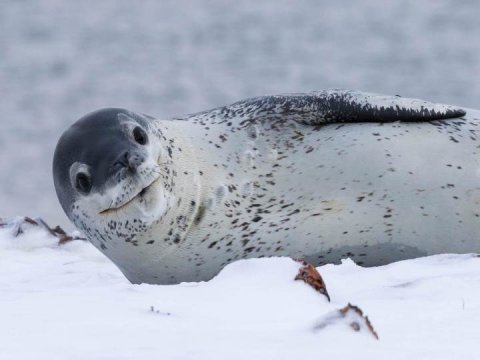[ad_1]
Scientists from British Antarctic Survey (BAS) have, for the first time, tracked the lives of leopard seals as they migrate around Antarctica. The team followed these formidable predators as they move from the frozen Antarctic sea-ice to the more northerly sub-Antarctic islands where they prey on penguins, seals and krill. The study is published this week (Tuesday 5 June) in the journal PLOS ONE.
During the harsh polar winter, leopard seals are regularly sighted on islands such as South Georgia, where BAS scientists have studied them for over 20 years. However, very little is known about their behaviour during the long Antarctic night.
Seal ecologist Dr Iain Staniland, lead author of the study says:
“Leopard seals are notoriously difficult to study because they live and hunt in inaccessible places: they are relatively scarce, lead solitary lives and live mostly in the water or ‘hauled out’ on sea ice around Antarctica.
“As one of the Antarctic’s apex predators, leopard seals can have large local impacts on their prey populations. They could be limiting the recovery of some fur seal colonies, for example, and are known to take a significant proportion of penguins from some smaller colonies — around 15% of the colony of gentoo penguins at one study site*. As ocean sentinels, they can reveal a lot about the health of an ecosystem and alert us to problems further down the food chain.”
To find out more about the leopard seal’s distribution and behaviour, the team attached 31 miniature tags to leopard seals between 2003 and 2012. The tags record sunrise and sunset times and have a wet/dry sensor. The tags have a long battery life, enabling them to track leopard seals for extended periods, but they do not transmit data so recovering the data is challenging. It requires that the seals are located and their tags removed while they are sleeping.
To date the BAS team has succeeded in recovering tags from five of the leopard seals. The data recovered shows that during the summer, the seals move south in and around the Antarctic sea ice where they feed on krill and fish and breed. In the winter, as sea ice around Antarctica expands, the seals return to the shallow coastal waters around the Antarctic and sub-Antarctic islands, where penguins, seals and krill provide them with the food they need to survive the long dark Antarctic winter.
As well as recording the complete migration of leopard seals for the first time, the study also reveals they spend up to one-third (31%) of their time out of the water but this behaviour changes markedly throughout the year. This fact will help improve the accuracy of population counts conducted using aircraft and drones.
Dr Iain Staniland continues:
“This study presents several important breakthroughs in our study of these fearsome predators. This is the first long-term deployments of tracking devices on leopard seals, the first opportunity to record the complete annual migration of leopard seals between the Antarctic pack ice and sub-Antarctic islands, and the first to record their haul-out behaviour.
“These findings will enable more robust population size estimates and to assess the role of leopard seals within the Southern Ocean ecosystem. It is a major advance in our knowledge about the secret life of one of the Antarctic’s true ‘apex’ predators.”
Story Source:
Materials provided by British Antarctic Survey. Note: Content may be edited for style and length.
[ad_2]















